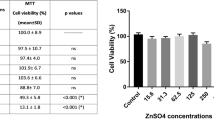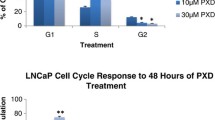Abstract
Prostate cancer is one of the most common cancers and the second cause of cancer-related deaths among men. Metals are recognized as chemical carcinogens where chronic exposures to such metals are implicated in the development of cancer, including prostate cancer. This in vitro study demonstrates the relative death sensitivity of prostatic (RWPE-1) cells to arsenic (As), cadmium (Cd), and chromium (Cr) as environmental pollutants through its apoptotic effects and the effect of these chemicals on prostate-specific antigen (PSA) gene expression as a marker for their carcinogecity. RWPE-1 cells were divided into three groups that were treated with As, Cd, and Cr in three replicates, at three different concentrations for each metal for 48 h. A control group consisted of untreated RWPE1 cells was used. Apoptosis was assessed using comet assay and caspase 3 gene expression; meanwhile, PSA gene expression was evaluated by semiqualitative real-time PCR (RT-PCR). One of the novel findings of this study is that arsenic and cadmium at low concentrations decreased apoptosis of RWPE-1 cells in a concentration-dependent manner while chromium induced significant concentration-dependent increase in apoptosis. Yet, at the highest concentrations, apoptosis was relatively more induced by all chemicals. Arsenic was the most chemical inhibiting apoptosis in RWPE-1 cells at low concentration. While at the moderate and highest concentrations, cadmium was the most inhibiting chemical of RWPE-1 cells’ apoptosis. No distinct differences between treated and untreated cells for PSA gene expression were observed. It can be concluded that As and Cd, at low concentrations, can reduce apoptosis of prostatic cells in a concentration-dependent manner while chromium induced it; however, all metal salts used in this study did not induce PSA gene expression.



Similar content being viewed by others
References
Lau ATY, Chiu J (2007) The possible role of cytokeratin 8 in cadmium-induced adaptation and carcinogenesis. Cancer Res 67:2107–2113
Sullivan JB, Krieger GR (2001) Clinical environmental health and toxic exposures, 2nd edn. Lippincott Williams & Wilkins, Philadelphia
Bertin G, Averbeck D (2006) Cadmium: cellular effects, modifications of biomolecules, modulation of DNA repair and genotoxic consequences. Biochimica 88(11):1549–1559
Mansour SA, Belal MH, Abou-Arab AAK, Gad MF (2009) Monitoring of pesticides and heavy metals in cucumber fruits produced from different farming systems. Chemosphere 75(5):601–609
Mansour SA, Gad MF (2010) Risk assessment of pesticides and heavy metals contaminants in vegetables: a novel bioassay method using Daphnia Magna Straus. Food Chem Toxicol 48(1):377–389
Benbrahim-Tallaa L, Waalkes MP (2008) Inorganic arsenic and human prostate cancer. Environ Health Perspect 116(2):158–164
Tokar EJ, Diwan BA, Waalkes MP (2010) Arsenic exposure transforms human epithelial stem/progenitor cells into a cancer stem-like phenotype. Environ Health Perspect 118(1):108–115
Yuanyuan XU, Tokar EJ, Sun Y, Waalkes MP (2012) Arsenic-transformed malignant prostate epithelia can convert noncontiguous normal stem cells into an oncogenic phenotype. Environ Health Perspect 120(6):865–871. doi:10.1289/ehp.1204987
Aimola P, Carmignani M, Volpe AR, Benedetto AD, Claudio L, Waalkes MP, Bokhoven AV, Tokar AJ, Claudio PP (2012) Cadmium induces p53-dependent apoptosis in human prostate epithelial cells. PLoS ONE 7(3):1–13
Gong X, An Z, Wanga Y, Guan L, Fang W, Strِmblad S, Jiang Y, Zhang H (2010) Kindlin-2 controls sensitivity of prostate cancer cells to cisplatin-induced cell death. Cancer Lett 299:54–62
National Cancer Institute (NCI), Cairo University, Egypt, Cancer Registry (2002–2003): 1–75
Lacorte LM, Delella FK, Porto Amorim EM, Justulin LA Jr, Godinho AF, Almeida AA, Felipe Pinheiro PF, Amorim RL, Felisbino SL (2011) Early changes induced by short-term low-dose cadmium exposure in rat ventral and dorsolateral prostates. Microsoft Res Technol 74(11):988–997
Prins GS (2008) Endocrine disruptors and prostate cancer risk. Endocrinol Relat Cancer 15(3):649–659
Taylor RC, Cullen SP, Martin SJ (2008) Apoptosis: controlled demolition at the cellular level. Nat Rev Mol Cell Biol 9:231–241
Shi Y (2001) A structural view of mitochondria-mediated apoptosis. Nat Struct Biol 8:394–401
Olive PL (1999) DNA damage and repair in individual cells: applications of the comet assay in radiology. Int J Radiat Biol 75:395–405
El-Gazzar ABA, Youssef MM, Youssef AMS, Abu-Hashem AA, Badria FA (2009) Design and synthesis of azolopyrimidoquinolines, pyrimidoquinazolines as anti-oxidant, anti-inflammatory and analgesic activities. Eur J Med Chem 44(2):609–624
Kumari R, Singh KP, DuMond JW (2009) Imulated microgravity decreases DNA repair capacity and induce DNA damage in human lymphocytes. J Cell Biochem 107:723–731
Winter RN, Kramer A, Borkowski A, Kyprianou N (2001) Loss of caspase-1 and caspase-3 protein expression in human prostate cancer. Cancer Res 61(3):1227–1232
Takahashi T, Hoshi S, Satoh M, Kaneda T, Suzuki K, Nakagawara K, Orikasa S (1999) The study of PSA gene expression on urogenital cell lines. Int J Urol 6:526–531
Achanzar WE, Brambila EM, Diwan BA, Webber MM, Waalkes MP (2002) Inorganic arsenite-induced malignant transformation of human prostate epithelial cells. J Natl Cancer Inst 94:1888–1891
Singh KP, Kumari R, Treas J, DuMond JW (2011) Chronic exposure to arsenic causes increased cell survival, DNA damage, and increased expression of mitochondrial transcription factor A (mtTFA) in human prostate epithelial cells. Chem Res Toxicol 24(3):340–349
Treas J, Tyagi T, Singh KP (2013) Chronic exposure to arsenic, estrogen, and their combination causes increased growth and transformation in human prostate epithelial cells potentially by hypermethylation-mediated silencing of MLH1. The Prostate, 1–13
Fusenig NE, Boukamp P (1998) Multiple stages and genetic alterations in immmortalization, malignant transformation, and tumor progression of human skin keratinocytes. Mol Carcinog 23:144–158
Benbrahim-Tallaa L, Waterland RA, Styblo M, Achanzar WE, Webber MM, Waalkes MP (2005) Molecular events associated with arsenic-induced malignant transformation of human prostatic epithelial cells: aberrant genomic DNA methylation and K-ras oncogene activation. Toxicol Appl Pharmacol 206:28–29
Thomas DJ (2007) Molecular processes in cellular arsenic metabolism. Toxicol Appl Pharmacol 222:365–373
Hartwig A, Schwerdtle T (2009) Arsenic-induced carcinogenicity: new insights in molecular mechanisms. In: Hadjiliadis N, Sletten E (eds) Metal complex–DNA interactions. Blackwell, West Sussex, pp 491–510
Huff J, Lunn RM, Waalkes MP, Tomatis L, Infante PF (2007) Cadmiuminduced cancers in animals and in humans. Int J Occup Environ Health 13:202–212
Chen YC, Pu YS, Wu HC, Wu TT, Lai MK, Yang CY, Sung FC (2009) Cadmium burden and the risk and phenotype of prostate cancer. BMC Cancer 9:429–436
Hartwig A (2013) Metal interaction with redox regulation: an integrating concept in metal carcinogenesis? Free Radic Biol Med 55:63–72
Achanzar WE, Diwan BA, Liu J, Quader ST, Webber MM, Waalkes MP (2001) Cadmium-induced malignant transformation of human prostate epithelial cells. Cancer Res 61:455
Elinder CG, Kjellström T, Hogstedt C, Andersson K, Spång G (1985) Cancer mortality of cadmium workers. Br J Ind Med 42(10):651–655
Wang TC, Jia G, Song YS, Zhang J, Ma YH, Feng WY, Liu LZ, Zhang N, Zhou JW, Yan L, Zhen S, Qian Q (2012) Effects of chronic chromate exposure on human serum prostate specific antigen: a cross sectional study. Ind Health 50:95–102
Huvinen M, Pukkala E (2013) Cancer incidence among Finnish ferrochromium and stainless steel production workers in 1967–2011: a cohort study. BMJ Open 3(11):e003819
Yao H, Guo L, Jiang BH, Luo J, Shi X (2008) Oxidative stress and chromium (VI) carcinogenesis. J Environ Pathol Toxicol Oncol 27:77–88
Salnikow K, Zhitkovich A (2008) Genetic and epigenetic mechanisms in metal carcinogenesis and co-carcinogenesis: nickel, arsenic, and chromium. Chem Res Toxicol 21:28–44
Wise SS, Holmes AL, Wise JP (2008) Hexavalent chromium- induced DNA damage and repair mechanisms. Rev Environ Health 23:39–57
Balk SP, Ko YJ, Bubley GJ (2003) Biology of porostate specific antigen. J Clin Oncol 21:383–391
Zeng X, Jin T, Jiang X, Kong Q, Ye T, Nordberg GF (2004) Effects on the prostate on environmental cadmium exposure—a cross sectional population study in China. Biometals 17:559–565
González SA, Tefaha L, Guber R, Arias N, Romero C, Martínez M, Valdivia M, Sandoval N, Toledo R, Czejack M (2011) Total prostatic specific antigen levels among subjects exposed and not exposed to arsenic in drinking water. Rev Med Chil 139(12):1581–1587
van Wijngaarden E, Singer EA, Palapattu GS (2008) Prostate-specific antigen levels in relation to cadmium exposure and zinc intake: results from the 2001–2002 National Health and Nutrition Examination Survey. Prostate 68(2):122–128
Pizent A, Colak B, Kljaković Z, Telisman S (2009) Prostate-specific antigen (PSA) in serum in relation to blood lead concentration and alcohol consumption in men. Arch Hig Rada Toksikol 60(1):69–78
De Coster S, Koppen G, Bracke M, Schroijen C, Den Hond E, Nelen V, Van de Mieroop E, Bruckers L, Bilau M, Baeyens W, Schoeters G, van Larebeke N (2008) Pollutant effects on genotoxic parameters and tumor-associated protein levels in adults: a cross sectional study. Environ Health 3(7):26
Wu CC, Pu YS, Wu HC, Yang CY, Chen YC (2011) Reversed association between levels of prostate specific antigen and levels of blood cadmium and urinary cadmium. Chemosphere 83(8):1188–1191
Author information
Authors and Affiliations
Corresponding author
Rights and permissions
About this article
Cite this article
El-Atta, H.M.A., El-Bakary, A.A., Attia, A.M. et al. DNA Fragmentation, Caspase 3 and Prostate-Specific Antigen Genes Expression Induced by Arsenic, Cadmium, and Chromium on Nontumorigenic Human Prostate Cells. Biol Trace Elem Res 162, 95–105 (2014). https://doi.org/10.1007/s12011-014-0100-y
Received:
Accepted:
Published:
Issue Date:
DOI: https://doi.org/10.1007/s12011-014-0100-y




